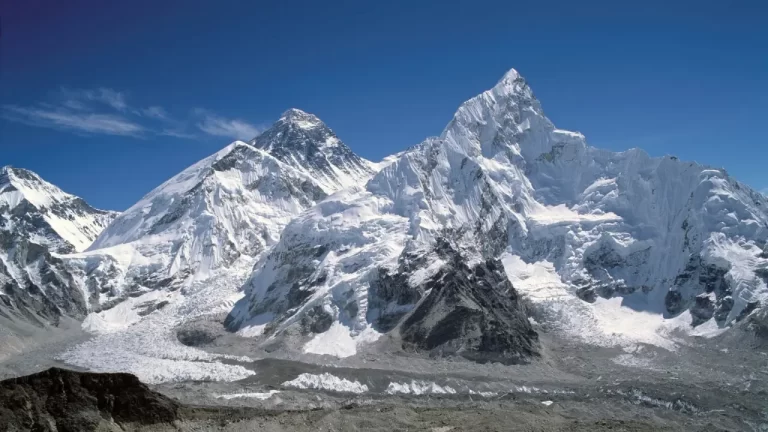Estimated reading time: 7 minutes
For students preparing for competitive exams in geography like UGC NET, UPSC, RPSC, and state-level teaching exams, understanding the ozone layer is crucial. This topic bridges environmental concerns with geographical implications, making it a potential question source. We’ll look into the ozone layer’s importance, its depletion, and the international response – knowledge that will equip you to tackle questions on environmental geography, atmospheric science, and current affairs.
Table of contents
The ozone layer, often referred to as Earth’s “invisible shield,” plays a critical role in protecting all forms of life from the sun’s harmful ultraviolet (UV) radiation. Situated in the stratosphere, approximately 15 to 35 kilometers above Earth’s surface, the ozone layer absorbs about 97-99% of the sun’s medium-frequency UV light, which otherwise would be detrimental to living organisms. However, human activities, especially the widespread use of ozone-depleting substances (ODS), have significantly damaged this natural barrier, leading to an environmental crisis that demands urgent attention and collaborative global action.
Why is the Ozone Layer Important?
| Function | Impact on Earth |
|---|---|
| Absorbs UV Radiation | Prevents skin cancers, cataracts, and immune system damage in humans |
| Protects Ecosystems | Shields aquatic life, especially plankton, which forms the base of many food chains |
| Maintains Climate Stability | Influences temperature and weather patterns in the stratosphere |
The Montreal Protocol: A Landmark Agreement
In response to the alarming degradation of the ozone layer, the international community adopted the Montreal Protocol in 1987. This treaty became a cornerstone in global environmental policy, aiming to phase out the production and consumption of key ODS such as chlorofluorocarbons (CFCs) and halons. These chemicals were once heavily used in everyday products like refrigerators, air conditioners, aerosol sprays, and fire suppression systems.
| Provisions | Target Year | Purpose |
|---|---|---|
| Freeze on CFC Production | 1989 | Capped production at 1986 levels to halt further atmospheric damage |
| Phased Reduction in CFCs | 1993, 1998 | Mandated 20% and 30% reductions in CFCs to allow industries to transition to safer alternatives |
| Halon Production Freeze | 1992 | Capped halon production at 1986 levels, while allowing limited exemptions |
These provisions marked a significant shift in global environmental governance, compelling both developed and developing nations to cooperate in mitigating ozone depletion.
Challenges and Limitations
Despite the Protocol’s success, several challenges and limitations hindered its full potential. Some key issues include:
1. Incomplete Halon Phase-out: While the production of halons was frozen, their complete phase-out was not enforced, leaving some regions vulnerable to continued emissions. Halons, used in fire extinguishers, are highly effective but contribute significantly to ozone depletion.
2. Exemptions for Developing Countries: Recognizing the economic constraints of developing nations, the treaty granted these countries a grace period until 1999 to meet reduction targets. However, this delayed compliance allowed for continued use of ODS, particularly in growing economies, raising concerns about potential spikes in emissions during the exemption period.
3. Unregulated ODS: Chemicals like methyl chloroform and carbon tetrachloride, though less commonly used, were not initially covered by the Protocol. This oversight allowed some ozone-depleting emissions to continue unchecked.
| Substance | Primary Use | Ozone Depletion Potential (ODP)* |
|---|---|---|
| CFCs | Refrigerants, air conditioners, aerosol sprays | 1 |
| Halons | Fire extinguishers | 3.0–10.0 |
| Methyl Chloroform | Industrial solvent | 0.1 |
| Carbon Tetrachloride | Cleaning agents, chemical production | 1.2 |
*ODP is a relative value that indicates the potential of a substance to deplete the ozone layer compared to CFC-11, which is given a value of 1.0.
The Path Forward: Transitioning to Safer Alternatives
As the dangers of ozone depletion became more apparent, scientists, governments, and industries worked together to develop safer, more sustainable alternatives to ODS. Several key efforts included:
1. Improved ODS Management: Regulations became stricter to prevent leaks and minimize emissions from existing CFCs and halons during usage and maintenance. For example, specialized equipment was introduced to detect and seal leaks in refrigeration systems.
2. Development of Chlorine-Free Alternatives: Hydrofluorocarbons (HFCs) emerged as a promising substitute for CFCs in refrigeration and air conditioning systems. Although HFCs have zero ozone depletion potential, they are potent greenhouse gases that contribute to global warming, leading to further environmental concerns.
3. Adoption of Alternatives: Financial incentives, subsidies, and awareness campaigns encouraged industries to switch to eco-friendly technologies. Governments facilitated this transition through public-private partnerships and international funding initiatives, particularly in developing countries.
| Ozone-Friendly Substitutes | Application | Environmental Impact |
|---|---|---|
| Hydrofluorocarbons (HFCs) | Refrigeration, AC | No impact on ozone, but contributes to climate change |
| Ammonia and CO2 | Industrial cooling | Ozone-safe and low global warming potential (GWP) |
Continued Vigilance and Global Cooperation
The Montreal Protocol is widely regarded as one of the most successful international environmental agreements, with over 197 countries having ratified it. Thanks to this collective effort, the ozone layer is showing signs of recovery, and it is projected to return to pre-1980 levels by the mid-21st century. However, ongoing vigilance is necessary to ensure this positive trend continues.
Key Areas of Focus Moving Forward:
1. Strengthening the Montreal Protocol: The Protocol has undergone several amendments to address new challenges, such as the phase-down of HFCs through the Kigali Amendment. These regular updates are crucial to maintaining the treaty’s effectiveness in the face of evolving environmental issues.
2. Phasing Out HFCs: While HFCs do not deplete the ozone layer, they have high global warming potential. The Kigali Amendment, adopted in 2016, calls for a phased reduction in HFC use, contributing to the dual goals of ozone layer protection and climate change mitigation.
3. Promoting Sustainable Practices: Industries are encouraged to adopt energy-efficient technologies and reduce waste. Consumers can also contribute by opting for eco-friendly products and appliances, thus playing their part in safeguarding the environment.
| Milestones in Ozone Recovery | Year Achieved | Global Impact |
|---|---|---|
| Montreal Protocol Signed | 1987 | First international agreement on ODS |
| Ozone Layer Stabilization | Early 2000s | Decline in ozone depletion observed |
| Projected Full Recovery | 2060s | Expected return to pre-1980 ozone levels |
By continuing to work together, we can protect the ozone layer, combat climate change, and ensure a healthier, more sustainable future for generations to come. The journey toward a fully healed ozone layer exemplifies how global cooperation and innovative solutions can address even the most daunting environmental challenges.
Test Your Knowledge with MCQs
1. What is the primary function of the ozone layer?
(a) Reflects solar radiation back to space
(b) Absorbs harmful UV radiation
(c) Regulates atmospheric pressure
(d) Generates oxygen
2. Which of the following is NOT an ozone-depleting substance (ODS)?
(a) Chlorofluorocarbons (CFCs)
(b) Halons
(c) Hydrofluorocarbons (HFCs)
(d) Methyl chloroform
3. The Montreal Protocol primarily targets the reduction of which substances?
(a) Greenhouse gases
(b) Particulate matter
(c) Ozone-depleting substances
(d) Volatile organic compounds
4. Which amendment to the Montreal Protocol focuses on phasing down hydrofluorocarbons (HFCs)?
(a) London Amendment
(b) Copenhagen Amendment
(c) Kigali Amendment
(d) Montreal Amendment
5. What is the projected year for the ozone layer to return to pre-1980 levels?
(a) 2030s
(b) 2040s
(c) 2050s
(d) 2060s
6. Why were developing countries granted exemptions under the Montreal Protocol?
(a) Their contribution to ozone depletion was negligible
(b) They lacked the technology to transition to alternatives
(c) They were given more time to comply due to economic constraints
(d) They were not significant users of ozone-depleting substances
7. Which of the following is a chlorine-free substitute for CFCs?
(a) Ammonia
(b) Carbon dioxide
(c) Hydrochlorofluorocarbons (HCFCs)
(d) All of the above
8. What is the Ozone Depletion Potential (ODP) of CFCs?
(a) 0.1
(b) 1.0
(c) 3.0
(d) 10.0
9. How does the ozone layer influence Earth’s climate?
(a) It traps heat in the troposphere
(b) It reflects incoming solar radiation
(c) It absorbs UV radiation, affecting stratospheric temperature and circulation
(d) It has no significant impact on climate
10. Which of the following is NOT a milestone in ozone layer recovery?
(a) Montreal Protocol signed in 1987
(b) Kigali Amendment adopted in 2016
(c) Ozone layer stabilization observed in the early 2000s
(d) Complete phase-out of halons achieved by 1995
Answers: 1(b), 2(c), 3(c), 4(c), 5(d), 6(c), 7(d), 8(b), 9(c), 10(d)
FAQs
Human activities, primarily the release of ozone-depleting substances (ODS) like CFCs and halons, have led to the thinning of the ozone layer. These substances break down ozone molecules, reducing the layer’s ability to absorb UV radiation.
The Montreal Protocol is a landmark international agreement signed in 1987 to phase out the production and consumption of ODS. It has been highly successful in reducing ODS emissions, leading to the gradual recovery of the ozone layer.
Individuals can support ozone layer protection by using eco-friendly products, properly disposing of old appliances containing ODS, and advocating for policies that promote sustainable practices and further reduce ODS emissions.




























